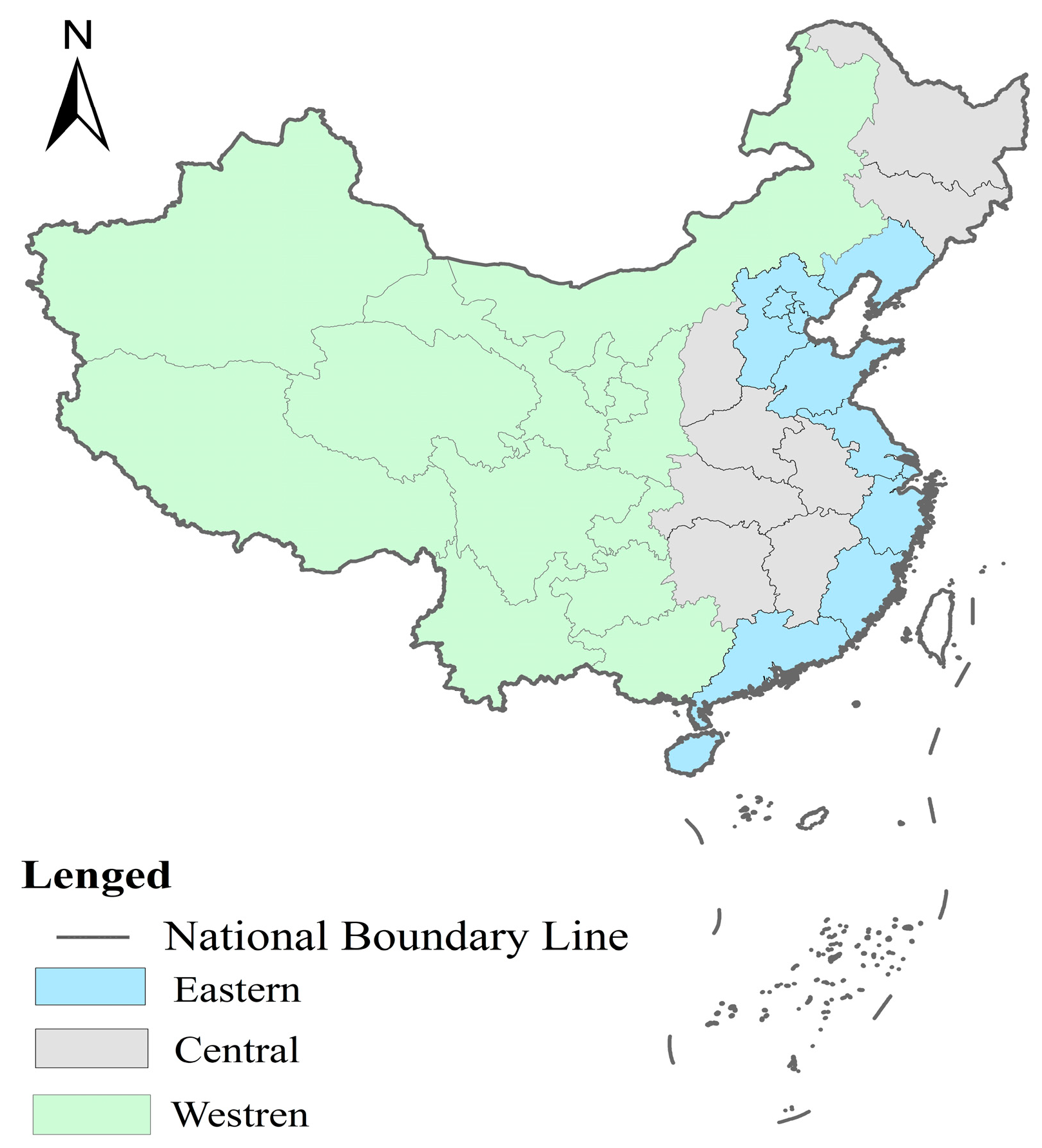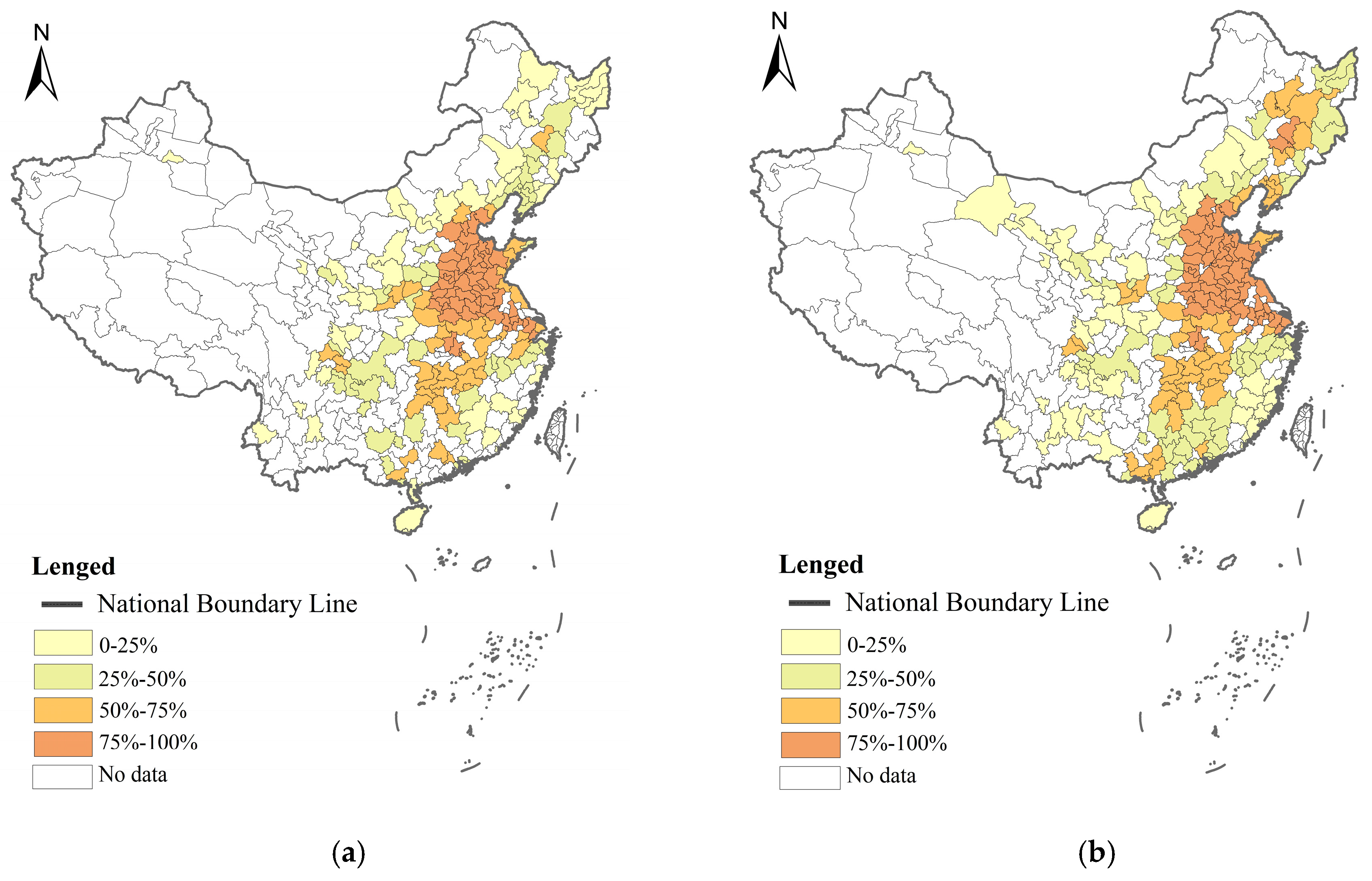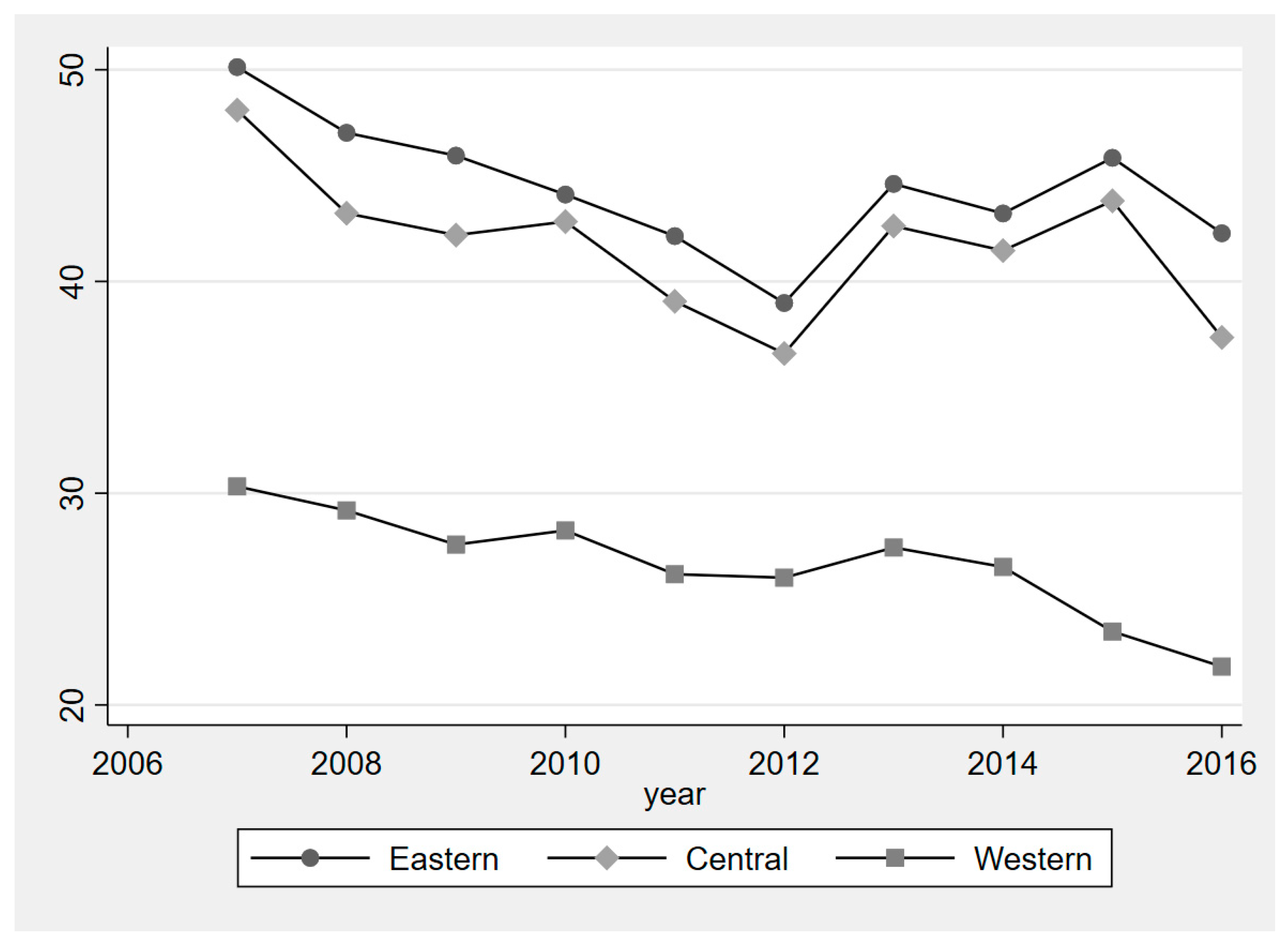1. Introduction
China’s urbanization ratio (measured by population) increased from 44.9% in 2007 to 58.52% in 2017, as the size of Chinese cities has grown rapidly. The number of cities with an urban population over 1 million increased from 57 in 2007 to 75 in 2016. Beijing and Shanghai have become megacities, whose populations have reached 18.79 million and 24.19 million, respectively. The continuous expansion of the city size has caused “urban diseases”, of which pollution has become the first and foremost. Han [
1] argued that the rapidly growing urbanized population in China has caused serious environmental pollution, particularly air pollution. Urban pollution is closely linked to the size of the city—as the size of the city increases, the total amount of urban pollution emissions increases. Therefore, the expansion of cities has created serious urban pollution and placed tremendous pressure on the environment. Urban pollution leads to economic losses and threatens the climate and human health. Xie et al. [
2] used a CGE (Computable General Equilibrium) model, a class of economic models that use actual economic data to estimate how an economy might react to changes, to estimate economic losses, where the results showed that without control measures, China will experience a 2.00% loss in gross domestic product (GDP) and a 25.2 billion USD increase in health expenditure from PM
2.5 (fine particulate matter) pollution in 2030. Tai [
3] found that there was a strong positive correlation between PM
2.5 components and temperature across most of the USA. Studies have shown that there is a causal relationship between PM
2.5 exposure and cardiovascular morbidity and mortality [
4]. A reduction in exposure to ambient fine-particulate air pollution has contributed to significant and measurable improvements in life expectancy in the United States [
5].
Air pollution has increasingly attracted public attention in China. In 2015, more than 99% of deaths due to household air pollution and approximately 89% of deaths due to ambient air pollution occurred in low-income and middle-income countries, and more than 50% of global deaths caused by ambient air pollution in 2015 occurred in India and China [
6]. The Chinese government has acknowledged the dangers posed by pollution and has set specific targets for environmental improvement and restrictions on the use of certain resources. China has implemented a vast network of stations to monitor air quality in more than 400 cities. The capacity to track emissions has been central to developing policy and to implementing data-driven regulatory frameworks. As a result, China has increased its reliance on non-fossil energy sources (predominantly renewables and nuclear) from 9.4% of total energy use in 2010 to 12.0% in 2015, surpassing the 12th Five-Year Plan target of 11.4% by 2015. The most recent Five-Year Plan aims to increase non-fossil energy use to at least 15% by 2020, and to at least 20% by 2030.
Although many preventive measures have been undertaken, the current condition of air pollution in China is still undeniably serious. In 2017, among the 338 prefecture-level (and above) cities, only 99 cities were reported to meet the environmental air quality standards, accounting for only 29.3% of the total number of cities. Moreover, the air quality of 239 cities was below standard, accounting for 70.7%. According to the National Ambient Air Quality Standards set by the U.S. EPA (Environmental Protection Agency), the PM
2.5 standard is 35 μg/m
3. As depicted in
Figure 1, in recent years, more than 70% of cities in China have not met the environmental standards.
Many cities have set out clear plans regarding city size limits in China. For example, from the perspective of ecological capacity (available water resources and per capita water resources), Beijing has determined that the size of its urban population should be under 23 million in the long term. According to the City Master Plan, many other cities have proposed controlling their city size (measured by population) such as Shanghai, Guangzhou, Shenzhen, and Wuhan. Controlling the size of the city seems to have become an important means of managing “urban diseases”. However, from another perspective, the expansion of city size is conducive to the formation of the urban economy of scale. The high concentration of the population has led to the intensive use of energy and an efficient reduction in pollution emissions, which has resulted in a gradual decline in per capita pollution. However, limiting the city size may not decrease the urban pollution.
City size is an important topic in urban economics research and is usually measured by urban population. The optimal city size is reached when the urban marginal costs equal the marginal benefits. Camagni et al. [
7] formulated an equilibrium urban size model and generated a model using 59 European cities, concluding that there was no single optimal city size as each city had its own “equilibrium” size. Duan [
8] used the cross-sectional data of 284 prefecture-level cities to study the optimal city size. On the basis of quantile regression, the city size was shown to be affected by factors such as market size, public finance, knowledge spillover, and urban–rural income gap. Wang [
9] reviewed China’s urbanization process and explored the optimal size and urbanization path of Chinese cities, which showed that the city size was related to the economic development level, traffic conditions, and geographical location. Pollution is another important topic. The Environmental Kuznets Curve (EKC) proposed by Grossman and Krueger [
10] explains the coordinated development of economic and environmental degradation. The EKC hypothesis argues that there exists an inverted U-shape between economic development and pollution, implying that environment pollution increases with economic output at an early stage, but decreases as economic output surpasses the inflection point. The EKC hypothesis has been validated in upper middle and high-income countries [
11], where the existence of the inverted U-shaped relationship has been adapted for different environmental degradation factors, such as CO
2 [
12], SO
2 [
13], and waste water [
14].
Some scholars have investigated the relationship between air pollution and city size; however, no consistent conclusions have been reached. Han et al. [
15] stated that large cities had contributions of 5.40 ± 4.80 µg/m
3·PM
2.5 year per million people in China. Shukla and Parikh [
16] focused on the relationship between ambient air quality and city size and studied the relationship theoretically and empirically using data from international cities. They found that a positive association between poor air quality and city size and developed–developing country differences emerged. Han [
17] selected 350 prefectures in China to estimate the nexus between PM
2.5 and city size using one-way analysis of variance (ANOVA) and Fisher’s least significant difference (LSD) and found that PM
2.5 was significantly correlated with city size. Oliveira [
18] found support of a power-law superlinear scaling behavior between CO
2 emissions and city size using data from U.S. cities. Cole and Neumayer [
19] found evidence that population increases were matched by proportional increases in carbon dioxide emissions and a U-shaped relationship for sulfur dioxide emissions. Crame [
20] made an empirical case study based on a modified IPAT (Human Impact, Population, Affluence and Technology) model and found that a large population was associated with a greater increase in air pollutant emissions. Zhang [
21] used panel data from 29 provinces spanning the period from 1997 to 2012 to demonstrate that population quality increased China’s carbon emissions. Liddle [
22] utilized panel regressions based on 12 different time spans in 80 countries to evaluate the carbon emissions elasticity of the population. Liddle’s results indicated that elasticity was likely not robust or statistically significantly different from either an OECD (the Organisation for Economic Co-operation and Development) or a non-OECD country. Zhou and Liu [
23] concluded that urbanization, represented by population, positively affected CO
2, particularly in China’s eastern and central regions. U-shaped relationships [
24] have also been detected, which suggests a complicated correlation between city size and the atmospheric environment.
Air pollution is the foremost form of urban pollution and has led to wide public concerns. Airborne particulate matter and ambient air pollution are proven group 1 human carcinogens [
25]. Urban population size and its related activities have been confidently attributed to urban air pollution, and there is a significant correlation between air pollution and the population [
26]. As the Chinese government is continually proposing new urbanization, it is bound to cause a further expansion of the city size. Will the expansion of city size inevitably lead to an increase in PM
2.5 pollution? What is the relationship between PM
2.5 pollution and city size? Can controlling the size of the city improve the quality of the urban environment? This paper aimed to answer these questions by examining the correlation between PM
2.5 pollution and city size. The goal of this study was to achieve a win–win situation for both city size and PM
2.5 pollution.
In general, the correlation between city size and air pollution has been widely studied based on different quantitative techniques, research areas, and variables. Several shortcomings still exist regarding the relationship between city size and air pollution. First, PM2.5 is the primary air pollutant of air pollution, but many previous studies have focused on other pollutants such as NOx and SO2. Therefore, there has been little research in terms of PM2.5, and an inadequate understanding of the relationship between city size and PM2.5 still remains. Second, studies have seldom taken into account the nonlinear relationship and regional heterogeneity for country-level research. Third, both panel and cross-section data and approaches have been used, but the endogeneity problem has been neglected. Therefore, this paper attempts to fill these gaps. This paper collected unbalanced panel data from 278 cities in China. The long time span and high number of observation samples allowed us to obtain a robust conclusion in comparison with previous studies based on provincial data. On the basis of the extended STIRPAT (Stochastic Impacts by Regression on Population, Affluence and Technology) model, a classic useful analytic tool for disciplining environmental policy with an empirical foundation, this study built fixed panel models to estimate the correlations between city size and PM2.5, and dynamic panel models were used for checking the robustness.
The remainder of the paper is organized as follows.
Section 2 presents the data description and model specification, which is followed by the empirical results and regional heterogeneity test in
Section 3 and
Section 4. Finally,
Section 5 presents our conclusions.
4. Regional Heterogeneity
China has a large territory with many differences between the regions. We divided the 30 provinces into three regions as per the official division method, which is mapped in
Figure 2. Both PM
2.5 and city size were different in the different regions. Cluster maps, showing the clusters and outliers of PM
2.5 concentrations for 2007 and 2016, are given in
Figure 3.
Figure 4 displays the average PM
2.5 concentration between 2007 and 2016 in the three different regions. The PM
2.5 concentration is higher in eastern China than that in central and western China. Overall, the past 10 years has witnessed a decrease in the PM
2.5 concentration. However, we can see quite different patterns in different regions. Although the PM
2.5 concentration was higher than in central China, there were some similarities between eastern and central China in the changing trends of PM
2.5 concentration. There were significant drops between 2007 and 2012, resulting in the lowest level in 2012. This was followed by a fluctuating increase until 2015. In 2016, there was a significant decline. In western China, the PM
2.5 concentration experienced a steady decrease from 2007 to 2016.
As for city size,
Figure 5 indicates the change in the urban population of the different regions. The city size in eastern China increased significantly and was larger than that in central and western China. The city size in central China was larger than that in western China; however, the urban population gap is closing all the time. Therefore, central and Western China have similarly witnessed a gradual increase in their urban population.
There were differences in both the PM2.5 concentration and city size among the three regions. In the National Main Functional Area Planning released by the Government of China, the land space in China has been divided into four areas: optimized development area, key development area, restricted development area, and prohibited development area. While most of the eastern and central regions belong to the optimized and key development areas, most of western China belongs to restricted and prohibited development areas.
PM
2.5 pollution in China has been proven to have regional differences [
43]. Wu [
44] found that the relationship between PM
2.5 and population in China was complex because of regional differences. Thus, we examined whether regional differences existed for the relationship between PM
2.5 and city size in a territory as vast as China.
The regional empirical results are shown in
Table 9. The F statistics were statistically significant at the 1% level, indicating that the three models were suitable and significant. There were differences in different regions, for example, in eastern China, an inverted N-shaped curve existed between PM
2.5 and city size that was significant at the 10% level and was in line with all sample regressions (shown in column 5,
Table 3). However, the relationship in central and western China was different. The results demonstrated a U-shaped curve relationship and a negative linear relationship in central and western China, respectively. In western China, the coefficients of per capita GDP were consistent for all cities, which negates the EKC hypothesis. The coefficients of per capita GDP in eastern and central China were contrary to those in western China at an insignificant level.
For the other controlled variables, energy consumption exhibited a negative impact on PM2.5, which was similar throughout China, with different levels of significance. While the economic structure exerted a significant and negative effect on PM2.5 in eastern and central China, a positive and significant effect was observed in western China. The effects of trade openness were positive but weak in all three regions. Public expenditure presented a negative and significant effect only for eastern China, with weak effects for central and western China.











